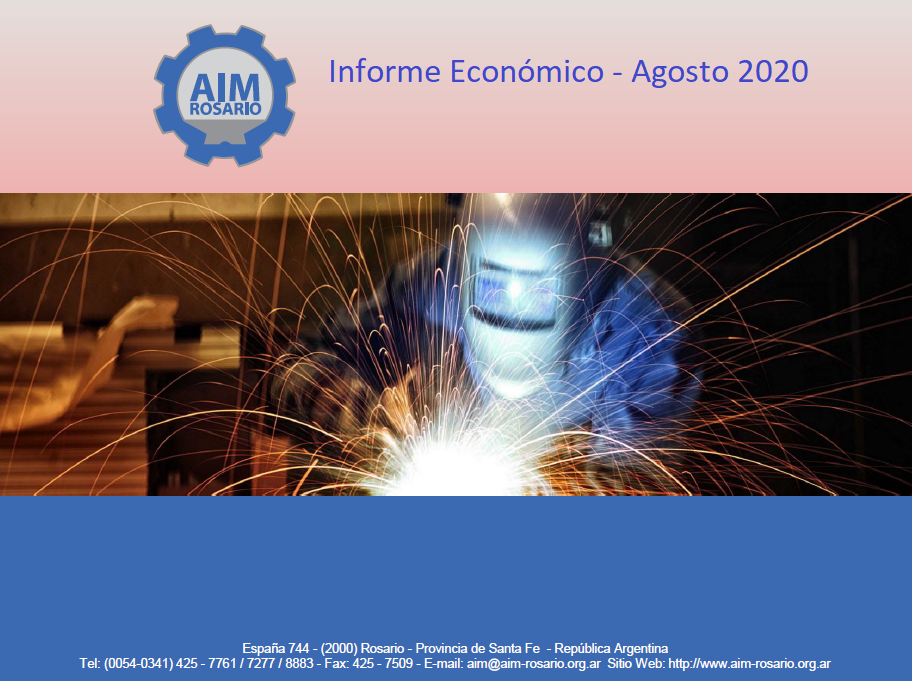Economic Report - August 2020
AIM ECONOMIC REPORT AUGUST 2020
ECONOMIC TAX DEPARTMENT
I. MUNICIPAL INFORMATION
1. In June 2020, the total billing indicator for the premises enabled in the
the city of Rosario showed a drop of 1.8%, in constant values, compared to
same month of the year 2019.
The seasonally adjusted indicator increased by 11.3% compared to May 2020.
The behavior of the accumulated January-June 2020 showed a drop of 14.6%
compared to the same period of the previous year.
2. The manufacturing industry fell 14.89% and 15.02% if we incorporate June 2020/June 2019.
Analyzing the main sectors by sector, we see that in January/June 2020 compared to its corresponding 2019, the manufacturing industry fell by 14.9%, construction by 54.6%, and commerce.io 9.4% and services 15.9%.
3. But among the manufacturing industry in the same period analyzed, metals, metal products and machinery fell by 21% and vehicles and transportation equipment fell by 31.8%.
The preceding statistical analysis arises from data from the Economic Information Center. Municipality of Rosario. Report is attached.
II. PROVINCIAL INFORMATION
The CPI Consumer Price Index grew by 2.5% comparing July/June 2020; The ISAE synthetic indicator of economic activity fell 14.3% comparing May 2020/May 2019; The cost of construction rose 2.51% July 2020/May 2020; Provincial exports fell 20.5% January/June 2020 compared to the same period last year; and the ISP Public Services Index fell 9% May 2020/May 2019
Analysis of data from the IPEC Provincial Institute of Statistics and Censuses
III. GENERAL CONSIDERATIONS
- The retraction is felt in general and in the manufacturing industry in particular; However, the behavior of the agroindustry must be examined, which follows the rhythm of the economy of the humid pampas and according to reports from the Institute of Economics of the Professional Council of Economic Sciences, agricultural activity, agroindustry and also other industrial sectors such as wood have resumed activity, surely shortening the previous decline.
- It is evident that Argentine problems are intact, both in terms of growth and external strangulation and inflation, which are limited by the recession, that is, the fall in demand, despite the fact that in the sectorstors that are in demand such as food or computers and cell phones, prices increase due to supply and demand problems.
- On 8/28/2020 there was a global video conference with opinions from economists from almost all countries organized by the FAPCE, Federation and Councils; In it, which lasted 4 hours, the opinions are consistent with the issue to maintain consumption, public works to reactivate, negative or zero rates as monetary policy.
- The Argentine situation is complicated by its chronic recession and bimonetarism.
- In general so far the measures in Argentina have been helpful to companies via soft credits, tariff subsidies, etc. and sustain consumption through subsidies to workers, that is, crisis measures to prevent consumption from falling further; but reactivation measures will be announced shortly.
- The issue has not yet impactedta prices, but it is a problem to be solved, liquidity is forming a mass of securities which is another issue that has become chronic; To date, the government understands that the exchange rate is correct, but it does not prevent capital flight; and deep down, poverty must have grown to considerable levels.
- We are immersed in a global catastrophe, with similar indicators, but in the Argentine case coming from quasi-chronic recessions, which makes ordering an economic solution an art itself that addresses fundamental economic and social problems.




.png)
.png)
.png)